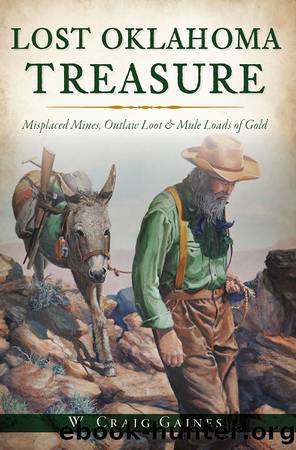Lost Oklahoma Treasure by W. Craig Gaines

Author:W. Craig Gaines
Language: eng
Format: epub
Publisher: Arcadia Publishing Inc.
Published: 2021-10-15T00:00:00+00:00
View from Council Hill. Authorâs photo.
D.L. Berryhill later related how when he was eight years old, he watched old Chief Opothleyahola pile $20 gold coins on the kitchen floor of the chief âs house. The chief and his close friend placed them in a trunk. One source said it was $159,700 or $160,000 in $20 gold pieces (worth $14 million today if it was about 480 pounds). I suspect $10,000 to $20,000 would be a more likely sum. Chief Opothleyahola ordered four slaves to haul the heavy trunk to a site near Opothleyaholaâs home in McIntosh County. The slaves excavated a hole and buried the trunk with the gold coins. His home was supposed to have been due west of Checotah at a fork in the road to Rigitsville, south on the Deep Fork River. Another burial site was said to be twelve miles west of Muskogee by a creek with five large four-foot-diameter trees around the burial site. Chief Opothleyahola and his friend murdered the unfortunate slaves to keep the location secret. Opothleyahola was said to have discussed the burial site when he was dying in a Kansas refugee camp.
Joe Grayson, D.L. Berryhillâs grandson, related his grandfatherâs tale to a newspaper reporter decades later. He claimed his grandfather told him where Chief Opothleyahola buried the Creek Nationâs treasure. Grayson said it was buried in McIntosh County a few miles southwest of Checotah, just north of the old village of Brush Hill, near a fork in the road. This road fork could be the turnoff to Okmulgee and Mission Hill. Grayson refused to give the exact details of the cache. He wanted the U.S. government to recover the treasure for the Creek tribe. Grayson offered to lead a search party but was unable to get anyone from the U.S. government to join him.
Another version of this story was that the Creek Nationâs money was put in a barrel rather than a trunk. There was just one slave who drove Chief Opothleyahola into the hills near his home. Chief Opothleyahola was known to have had a buggy, so maybe they used his buggy rather than a wagon. A hole was dug, and the barrel of gold was hidden in the ground. To conceal the treasureâs location, Opothleyahola murdered his slave.
Chief Opothleyahola left his home and led the pro-Union Indians and African Americans to oppose the McIntoshes and their supporters. Daniel N. âDodeâ McIntosh and his half brother, Chilly McIntosh, were Confederate Creek leaders. The McIntosh brothers were sons of General William McIntosh, a Lower Creek chief, who had been murdered in Georgia in 1828 by Opothleyaholaâs followers for signing a treaty that exchanged all Creek lands in Georgia and some Creek lands in Alabama for lands in Indian Territory.
When the Civil War began, Daniel McIntosh raised a Confederate flag over the Creek Agency. The pro-Confederate McIntoshes and other Indian tribes signed treaties with the Confederacy, with Albert Pike being the Confederate Indian agent. Pike was a Confederate brigadier general during the Civil War and a member of the Knights of the Golden Circle (see chapter 4).
Download
This site does not store any files on its server. We only index and link to content provided by other sites. Please contact the content providers to delete copyright contents if any and email us, we'll remove relevant links or contents immediately.
The Killing of Lord George by Shaw Karl;(219)
Grim Investigations by unknow(159)
Altered States of America by Richard Stratton(155)
The Price of Life by Jenny Kleeman(155)
How to Disappear Completely and Never Be Found by Unknown(152)
Notorious Antebellum North Alabama by O’Brien John;(136)
Tales from the Blue Line by Rob Riley(133)
Cemetery John by Robert Zorn(104)
Biz-Op: How to Get Rich With "Business Opportunity" Frauds and Scams by Bruce Easley(86)
The Man Who Mailed Himself Out of Jail by Byron Christopher(83)
A New History of the American South by W. Fitzhugh Brundage(83)
Stolen from the Valley by Leviticus(82)
Lost Oklahoma Treasure by W. Craig Gaines(76)
Dirty Money: Bcci : The Inside Story of the World's Sleaziest Bank by Mark Potts Nicholas Kochan Robert Whittington(66)
Missouri's Wicked Route 66 by Lisa Livingston-Martin(56)
General report and review of contributions by Unknown(52)
A Stone on Trial by Unknown(49)
Lead Poisoning: 25 True Stories From the Wrong End of a Gun by Chris Pfouts(48)
Murder at Holy Cross by Peter Davidson(45)
